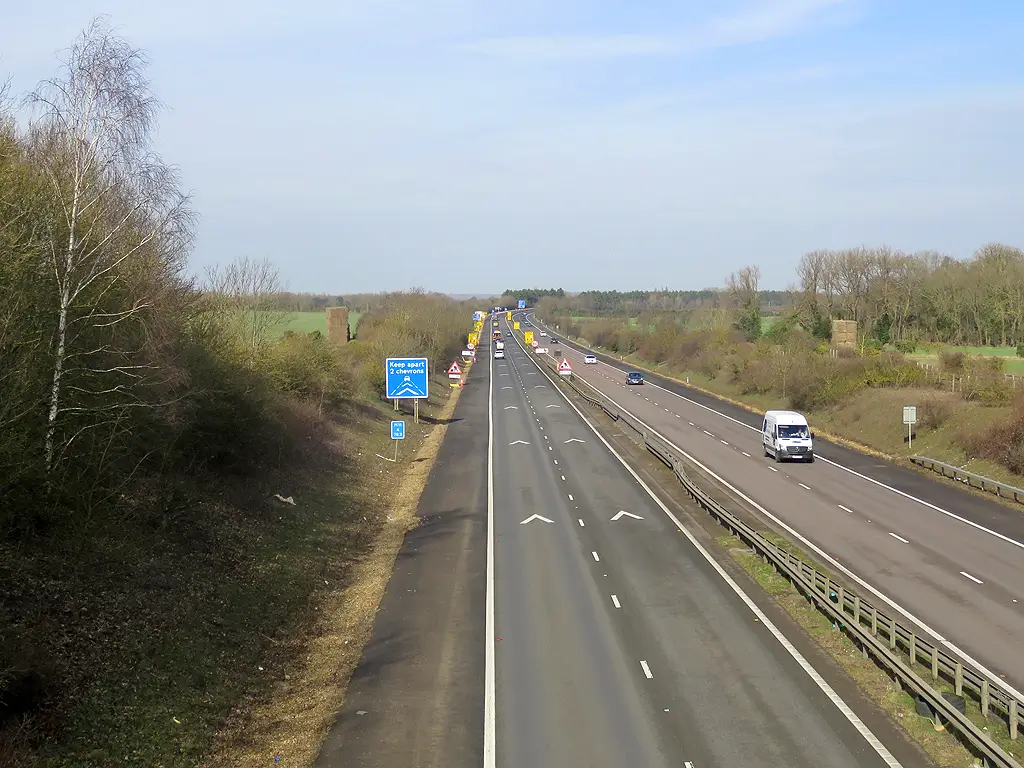The two-second rule in driving is a driving technique used in the United Kingdom to help maintain a safe following distance behind the vehicle in front of you. The rule states that you should keep a distance of at least two seconds behind the vehicle in front of you.
Use the following jump links to get to the information you need quickly:
How to Use the 2 Second Rule | Why the Two Second Rule is Good |
What is a Safe Driving Distance Between Cars? | Extra Time During Wet Weather? |
When to Use the Two Second Rule? | Why is There a Two Second Rule? |
Driver Reaction Time | Only a Fool Breaks the Two Second Rule
How to use the 2 second rule
To use the two-second rule, you should first choose a fixed point ahead of the vehicle in front of you, such as a signpost, road marking or a tree. When the vehicle in front of you passes that fixed point, start counting “one thousand and one, one thousand and two” (or use any other consistent timing method that doesn’t involve looking away from the road). If you reach the fixed point before you finish counting, you are following too closely and should increase your distance.

Photo © John Sutton (cc-by-sa/2.0) See original.
You’ll occasionally see markings on the road on motorways and dual carriageways that are marked with a safe breaking distance using chevrons in the lane, and if you use the two second rule when following a car in front, this gives you a good idea of how well you’re timing the two second rule.
Why the two second rule is good for safety
The two-second rule is an important safety technique because it gives you enough time and space to react if the vehicle in front of you suddenly brakes or takes other evasive action. It is particularly important when driving at higher speeds or in adverse weather conditions, such as rain or fog, which can reduce visibility and increase stopping distances.
What is the safe distance to drive from the car in front of you?
The safe distance to drive from the car in front of you varies depending on several factors, such as the speed you’re driving, road conditions, weather conditions, and the size and weight of your vehicle.
It’s worth noting that the two-second rule is a minimum guideline, and you should increase your following distance even further in certain situations, such as when towing a trailer, driving a larger or heavier vehicle, or driving on slippery roads.
How much should the 2 second rule be increased during wet or poor weather?
During wet weather, it is recommended that you increase your following distance beyond the standard two-second rule. This is because wet roads can reduce your vehicle’s traction and increase your stopping distance. A good guideline is to double your following distance to at least four seconds in wet weather.
If you are driving in heavy rain, fog, or other hazardous weather conditions, you may need to increase your following distance even further to allow for reduced visibility and longer stopping distances. In such situations, it’s also important to slow down and drive at a speed appropriate for the weather conditions.
When should you use the two second rule?
The two-second rule should be used to check distances and make sure you are following far enough away, and it can be used at any time when following a vehicle at speed. Obviously it is important to remember to increase the time counted in poor weather conditions or bad visibility. It is also a great driving technique to keep drivers more alert during night time driving and on long journeys, such as on motorways, where it is easier for concentration to slip and the act of repeatedly checking driving distances using the two second rule will keep attention on the traffic around you.
Why is there a two second rule?
When a driver follows too closely behind another vehicle, they reduce their reaction time and increase their risk of collision. This is because they have less time to perceive and respond to sudden changes in traffic, such as sudden braking or swerving. A shorter following distance therefore increases the likelihood of a rear-end collision if the vehicle in front of them suddenly stops or slows down.
Driver reaction time and the 2 second rule
The average human reaction time is around 0.25 to 0.75 seconds. This is the time it takes for a person to perceive a stimulus, such as a traffic signal or the brake lights of the car in front of them, and initiate a physical response, such as pressing the brake pedal. If the car in front brakes rapidly, even if you react as fast as you can, your car is likely to be travelling faster than the car in front right up until the point at which it stops, as the car in front will have started breaking sooner and therefore be slowing down faster. This means you will cover a further distance than that car and not leaving at least two seconds gap between cars means you don’t have that difference in breaking distance to stop your car hitting the car in front.
Reaction times can be affected by various factors, such as age – older adults tend to have slower reaction times than younger ones, fatigue – not getting enough sleep or taking enough breaks on a long journey, and distractions such as talking, drinking and eating, changing a radio station or phone use..
It’s important for drivers to be aware of their own reaction times and adjust their driving behaviour accordingly and by maintaining a minimum following distance of two seconds, drivers can reduce their risk of colliding with the vehicle in front of them. The two-second rule helps to take into account the average perception and reaction times of drivers and provides a safer buffer zone between vehicles. Just remembering the rule and applying it means that you are already being more attentive while you drive, as it provides constant reasons to be vigilant.
Only a fool breaks the 2 second rule
(How to count two seconds accurately!)
The phrase “only a fool breaks the two second rule” can be said in around two to three seconds, depending on the speed at which it is spoken. However, the actual time it takes to say the phrase may vary depending on factors such as the speaker’s accent, cadence, and pronunciation. Practice saying this against a stopwatch on your phone so that you get the timing about right and it’s a quick way to check whether you’re roughly the right distance away from a vehicle in front.
Overall, the two-second rule is a simple but effective way to help drivers stay safe on the road and avoid accidents, as it gives a good idea of safe space to leave between cars and helps you to maintain a safe distance at varying speeds. By following this rule, you can help improve your awareness, reduce risk of collisions, and make the roads safer for everyone.
Last updated: 03/01/2024

